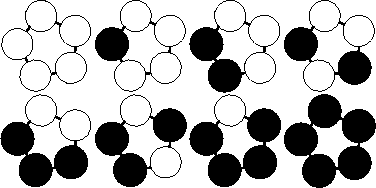poj 2409 Let it Bead Polya波利亚定理
来源:互联网 发布:网页编程课程设计 编辑:程序博客网 时间:2024/06/06 17:58
Let it Bead
Time Limit: 1000MS Memory Limit: 65536KTotal Submissions: 5054 Accepted: 3362
Description
"Let it Bead" company is located upstairs at 700 Cannery Row in Monterey, CA. As you can deduce from the company name, their business is beads. Their PR department found out that customers are interested in buying colored bracelets. However, over 90 percent of the target audience insists that the bracelets be unique. (Just imagine what happened if two women showed up at the same party wearing identical bracelets!) It's a good thing that bracelets can have different lengths and need not be made of beads of one color. Help the boss estimating maximum profit by calculating how many different bracelets can be produced.
A bracelet is a ring-like sequence of s beads each of which can have one of c distinct colors. The ring is closed, i.e. has no beginning or end, and has no direction. Assume an unlimited supply of beads of each color. For different values of s and c, calculate the number of different bracelets that can be made.
A bracelet is a ring-like sequence of s beads each of which can have one of c distinct colors. The ring is closed, i.e. has no beginning or end, and has no direction. Assume an unlimited supply of beads of each color. For different values of s and c, calculate the number of different bracelets that can be made.
Input
Every line of the input file defines a test case and contains two integers: the number of available colors c followed by the length of the bracelets s. Input is terminated by c=s=0. Otherwise, both are positive, and, due to technical difficulties in the bracelet-fabrication-machine, cs<=32, i.e. their product does not exceed 32.
Output
 For each test case output on a single line the number of unique bracelets. The figure below shows the 8 different bracelets that can be made with 2 colors and 5 beads.
For each test case output on a single line the number of unique bracelets. The figure below shows the 8 different bracelets that can be made with 2 colors and 5 beads.Sample Input
1 12 12 25 12 52 66 20 0
Sample Output
123581321
Source
Ulm Local 2000
我是小白,初识Polya定理。
不过看了各种代码,自己琢磨了半天,似乎有这么一回事:
对于一个置换
1,2,3,4,...,n
1,2,3,4,...,n
现在进行顺时针,或逆时针旋转(就是把底下一行推进一格或置后一格,再把多出的元素补到空位上)
操作k次,那么得到的置换群可以表示为循环的个数为gcd(n,k);
现在考虑翻转操作:
如果n是奇数:那么循环个数为 (n+1)/2;
如果n是偶数:那么要循环n次,其中n/2个置换群可以表示为 n/2个循环,还有n/2个可以表示为(n+2)/2个循环。
#include<cstdio>#include<string>#include<cstring>#include<iostream>#include<cmath>#include<algorithm>#include<climits>#include<queue>#include<vector>#include<map>#include<sstream>#include<set>#include<stack>#include<cctype>#include<utility>#pragma comment(linker, "/STACK:102400000,102400000")#define PI 3.1415926535897932384626#define eps 1e-10#define sqr(x) ((x)*(x))#define FOR0(i,n) for(int i=0 ;i<(n) ;i++)#define FOR1(i,n) for(int i=1 ;i<=(n) ;i++)#define FORD(i,n) for(int i=(n) ;i>=0 ;i--)#define lson num<<1,le,mid#define rson num<<1|1,mid+1,ri#define MID int mid=(le+ri)>>1#define zero(x)((x>0? x:-x)<1e-15)#define mk make_pair#define _f first#define _s secondusing namespace std;//const int INF= ;typedef long long ll;//const ll inf =1000000000000000;//1e15;//ifstream fin("input.txt");//ofstream fout("output.txt");//fin.close();//fout.close();//freopen("a.in","r",stdin);//freopen("a.out","w",stdout);const int INF =0x3f3f3f3f;//const int maxn= ;//const int maxm= ;//by yskysker123int n,m;int main(){ while(~scanf("%d%d",&m,&n)&&(m||n)) { int ans=0; for(int i=1;i<=n;i++) { ans+=pow(m,__gcd(i,n)); } if(n&1) ans+=n*pow(m,(n+1)/2); else ans+=n/2*pow(m,n/2)+n/2*pow(m,(n+2)/2); ans/=2*n; printf("%d\n",ans); } return 0;} 0 0
- POJ 2409 Let it Bead Polya定理
- POJ 2409 - Let it Bead【Polya定理】
- poj 2409 Let it Bead Polya定理
- poj 2409 Let it Bead Polya波利亚定理
- poj 2409 Let it Bead(polya定理)
- POJ 2409 Let it Bead polya 定理 和 置换
- 【裸polya定理】poj 2409 Let it Bead
- poj 2409 Let it Bead(polya 定理)
- 置换群Polya定理(poj 2409: Let it Bead)
- POJ 2409 Let it Bead(Polya定理)
- 2409 Let it Bead //polya 定理
- POj 2409 Let it Bead ----- polya计数
- POJ 2409 Let it bead 【裸polya】
- poj 2409 Let it Bead Polya计数
- poj 2409 Let it Bead (polya)
- POJ 2409-Let it Bead(Polya计数)
- POJ 2409 Let it Bead ACM Polya
- POJ 2409 Let it Bead(polya)
- Threat Intelligence-Driven Risk Analysis
- SQLServer 2014 内存优化表
- int ,long , long long, __int64等类型的范围
- sfd01
- PHPStorm与查找相关的快捷键
- poj 2409 Let it Bead Polya波利亚定理
- Centos 6.5 搭建 nginx服务器
- php 魔法函数 __autoload()
- ios文件,图片上传服务器
- Python学习
- python初级教程:入门详解
- Spring reactor框架简介
- html判断当前页面是否在iframe中
- validform 一行代码验证数字可以含小数点


